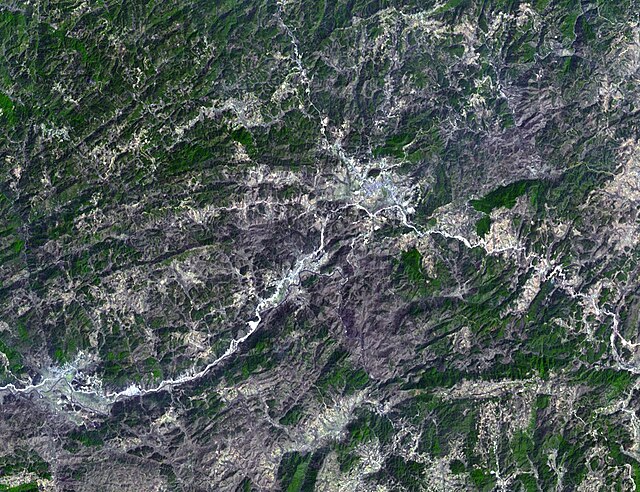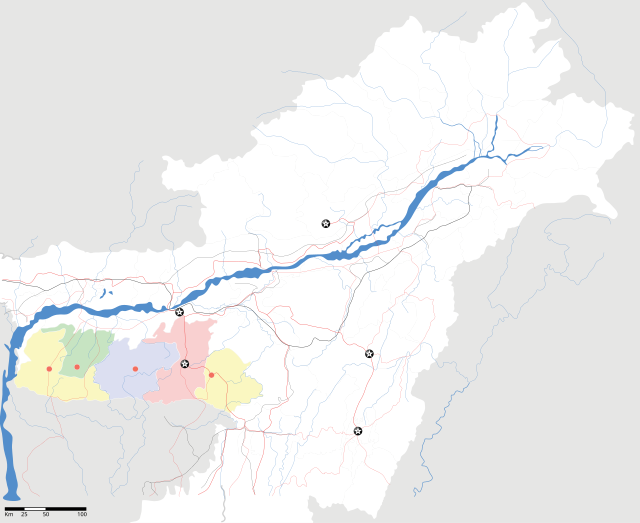Have you ever wondered what it’s like to live in a place where rain isn’t just weather—it’s a way of life? Welcome to Mawsynram, a small village nestled in the East Khasi Hills of Meghalaya, India, where the very air seems to breathe moisture and the landscape tells stories written in raindrops.
Geographic Location and Significance
Mawsynram sits like a jewel in the crown of the Khasi Hills, approximately 15 kilometers from Cherrapunji and about 56 kilometers from Shillong, the capital of Meghalaya. This unassuming village, home to fewer than 1,000 residents, occupies one of the most meteorologically significant spots on our planet.
The village rests at an elevation of about 1,400 meters above sea level, positioning it perfectly to intercept the moisture-laden winds that sweep in from the Bay of Bengal. It’s like nature’s own rain-catching amphitheater, designed to squeeze every drop of moisture from the passing clouds.
The Title of World’s Wettest Place
Since 1985, Mawsynram has held the prestigious (though somewhat soggy) title of the world’s wettest place, receiving an average annual rainfall of approximately 11,871 millimeters—that’s nearly 40 feet of rain each year! To put this in perspective, most places around the world receive less than 1,000 millimeters annually.
This incredible record isn’t just a number—it represents a unique climatic phenomenon that has shaped everything from the local culture to the very architecture of the homes in this remarkable village.
Understanding Mawsynram’s Climate Patterns

Monsoon Season: The Heart of Mawsynram Weather
If Mawsynram were a symphony, the monsoon season would be its crescendo. From June through September, this region transforms into nature’s most impressive water show, where rainfall isn’t measured in drops but in torrents.
Southwest Monsoon Impact
The southwest monsoon winds, loaded with moisture from the Arabian Sea and Bay of Bengal, arrive in Mawsynram like clockwork each year. These winds encounter the steep slopes of the Khasi Hills and are forced upward, causing rapid cooling and condensation—a process meteorologists call orographic rainfall.
Think of it as nature’s version of wringing out a wet towel. The warm, moist air hits the mountains and has nowhere to go but up, where it cools, condenses, and falls as rain with remarkable consistency and intensity.
Rainfall Distribution Throughout the Year
The rainfall distribution in Mawsynram follows a distinct pattern. While the village receives rain throughout the year, nearly 80% of its annual precipitation occurs during the four monsoon months. June typically sees the arrival of the monsoon, with rainfall gradually intensifying through July and August before beginning to taper off in September.
Temperature Variations in Mawsynram
Despite its reputation for extreme rainfall, Mawsynram maintains surprisingly moderate temperatures throughout the year, thanks to its elevation and constant cloud cover.
Summer Temperature Ranges
During the summer months (March to June), temperatures in Mawsynram typically range between 15°C to 25°C (59°F to 77°F). The pre-monsoon period can feel somewhat warmer, but the onset of the monsoon brings immediate cooling, creating a natural air conditioning system that keeps temperatures comfortable even during the wettest months.
Winter Weather Conditions
Winter in Mawsynram (December to February) is characterized by cool, crisp weather with temperatures ranging from 2°C to 15°C (36°F to 59°F). While rainfall decreases significantly during this period, the village rarely experiences completely dry days. Morning mists and occasional drizzles are common, creating an ethereal atmosphere that many visitors find enchanting.
Monthly Weather Breakdown
Peak Monsoon Months (June-September)
These four months are when Mawsynram truly lives up to its reputation. June marks the monsoon’s arrival with increasing rainfall intensity. July and August are the absolute wettest, often recording over 2,500 millimeters of rainfall each month. September begins the gradual retreat of the monsoon, though substantial rainfall continues.
During these months, visitors should expect continuous rain, with brief respites that locals have learned to predict and utilize for essential outdoor activities.
Post-Monsoon Period (October-November)
The post-monsoon period offers a different perspective of Mawsynram’s weather personality. Rainfall decreases to more manageable levels—still significant by global standards but refreshingly lighter for local residents. This period often features the most spectacular views, as clearing skies reveal the lush, rain-washed landscape in all its glory.
Winter Months (December-February)
Winter brings Mawsynram’s driest weather, though “dry” is relative in the world’s wettest place. Monthly rainfall during winter typically ranges from 20 to 100 millimeters, creating ideal conditions for outdoor exploration and photography.
The cool, clear mornings often give way to misty afternoons, creating a mystical atmosphere that has inspired countless visitors and researchers alike.
Pre-Monsoon Season (March-May)
The pre-monsoon months serve as nature’s intermission before the grand performance begins again. Temperatures gradually rise, humidity increases, and occasional thunderstorms hint at the approaching monsoon season. This period offers perhaps the most balanced weather conditions in Mawsynram’s annual cycle.
Factors Influencing Mawsynram Weather
Topographical Influences
The unique topography of the region plays the starring role in Mawsynram’s weather drama. The village’s position creates a perfect storm of meteorological conditions that result in its record-breaking rainfall.
Khasi Hills Effect
The Khasi Hills act like a massive barrier, forcing moisture-laden winds to rise rapidly. This orographic lifting is so effective that by the time these winds reach Mawsynram, they’ve released an enormous amount of their moisture content. It’s nature’s most efficient rain-making machine.
Elevation and Orographic Rainfall
At 1,400 meters above sea level, Mawsynram sits at the optimal height for maximum orographic rainfall. Lower elevations wouldn’t force sufficient cooling, while higher elevations might push the moisture beyond the condensation zone. Mawsynram occupies the meteorological sweet spot.
Bay of Bengal Moisture
The Bay of Bengal serves as the primary moisture source for Mawsynram’s incredible rainfall. The warm waters of the bay evaporate continuously, loading the atmosphere with water vapor that eventually finds its way to the Khasi Hills. This oceanic moisture highway operates with remarkable consistency, ensuring Mawsynram’s water supply year after year.
Comparing Mawsynram with Other Wet Destinations
Mawsynram vs Cherrapunji
The rivalry between Mawsynram and nearby Cherrapunji for the title of world’s wettest place is one of meteorology’s most interesting competitions. While Cherrapunji held the record for many decades and still maintains some impressive rainfall records, Mawsynram’s consistently higher annual averages since 1985 have secured its position as the current titleholder.
The difference often comes down to micro-climatic variations—Mawsynram’s slightly different elevation and orientation create marginally more favorable conditions for sustained rainfall.
Global Rainfall Comparisons
When compared to other notably wet places worldwide, Mawsynram stands in a league of its own. Hawaii’s Mount Waialeale receives about 9,750 millimeters annually, while Colombia’s Lloró gets approximately 13,300 millimeters, but these locations lack Mawsynram’s consistency over multiple decades.
Best Time to Visit Mawsynram
Weather Considerations for Tourists
Choosing when to visit Mawsynram depends entirely on what kind of experience you’re seeking. Are you coming to witness the full fury of the monsoon, or do you prefer to explore during calmer weather conditions?
Seasonal Travel Recommendations
For those seeking to experience Mawsynram’s claim to fame, visiting during peak monsoon season (July-August) offers the most authentic experience. However, be prepared for challenging travel conditions and limited outdoor activities.
Winter months (December-February) provide the most comfortable conditions for sightseeing, photography, and interaction with local communities. The post-monsoon period (October-November) offers a perfect balance of manageable weather and stunning scenery.
Weather Challenges and Adaptations
Local Infrastructure and Weather
Living in the world’s wettest place requires unique adaptations. Local architecture features steep-sloped roofs, elevated foundations, and innovative drainage systems. Roads are built with exceptional drainage considerations, though they still face constant challenges during peak rainfall periods.
How Residents Cope with Extreme Rainfall
The resilience of Mawsynram’s residents is truly remarkable. They’ve developed sophisticated methods for predicting weather patterns, timing agricultural activities, and maintaining their daily routines despite the challenging conditions. Traditional knowledge passed down through generations includes techniques for reading cloud formations, wind patterns, and other natural indicators.
Climate Change Impact on Mawsynram Weather
Recent studies suggest that climate change may be affecting traditional rainfall patterns in Mawsynram. While annual totals remain high, some researchers have noted shifts in timing and intensity distribution. These changes could have significant implications for local agriculture, water management, and tourism patterns.
The village serves as an important monitoring station for understanding how extreme weather locations respond to global climate variations.
Planning Your Trip: Weather Essentials
What to Pack for Different Seasons
Visiting Mawsynram requires careful preparation regardless of the season. During monsoon months, waterproof clothing, sturdy rain boots, and quick-dry fabrics are essential. Winter visits require warm layers, as temperatures can drop significantly, especially during early morning and late evening hours.
Weather Preparation Tips
Always carry backup waterproof storage for electronics and important documents. Local weather can change rapidly, so flexible itineraries work best. Consider bringing a portable weather radio to stay updated on conditions, especially during monsoon season.
Conclusion
Mawsynram’s weather represents one of nature’s most extraordinary phenomena—a place where rain isn’t just precipitation but a defining characteristic that shapes every aspect of life. From its record-breaking monsoons to its surprisingly pleasant winter months, Mawsynram offers weather enthusiasts and adventure seekers a unique opportunity to experience Earth’s most intense rainfall patterns.
Whether you visit during the thunderous monsoon season or the peaceful winter months, Mawsynram will leave you with a deeper appreciation for the power and beauty of weather. This small village continues to hold its title as the world’s wettest place, serving as a living laboratory for understanding extreme precipitation and its effects on human communities.
The weather in Mawsynram isn’t just a topic of conversation—it’s a way of life that has created one of the most unique communities on Earth. As climate patterns continue to evolve globally, places like Mawsynram become increasingly important for understanding the extremes of our planet’s weather systems.
Frequently Asked Questions
Q1: What is the average annual rainfall in Mawsynram?
Mawsynram receives an average annual rainfall of approximately 11,871 millimeters (467 inches), making it the wettest place on Earth according to the Guinness World Records.
Q2: When is the best time to visit Mawsynram for pleasant weather?
The best time to visit Mawsynram for comfortable weather conditions is during the winter months (December to February) when rainfall is minimal and temperatures are cool and pleasant.
Q3: How does Mawsynram’s weather compare to Cherrapunji?
While both locations receive extreme rainfall, Mawsynram has maintained higher average annual precipitation since 1985, securing its position as the world’s wettest place, though Cherrapunji still holds several single-day and monthly rainfall records.
Q4: What causes Mawsynram to receive so much rainfall?
Mawsynram’s extreme rainfall is caused by orographic precipitation, where moisture-laden winds from the Bay of Bengal are forced upward by the Khasi Hills, causing rapid cooling and condensation that results in heavy rainfall.
Q5: Can tourists visit Mawsynram during monsoon season?
Yes, tourists can visit during monsoon season (June-September), but they should be prepared for challenging travel conditions, continuous heavy rainfall, and limited outdoor activities. Proper waterproof gear and flexible itineraries are essential.

